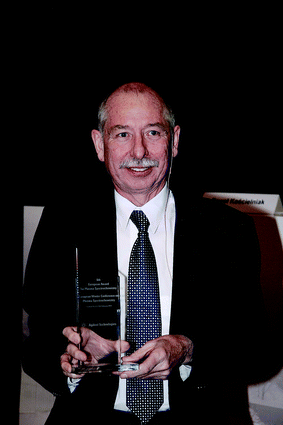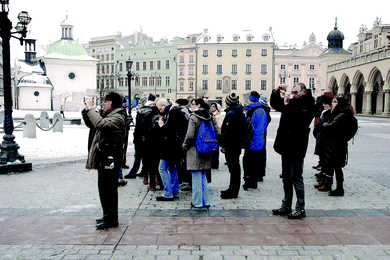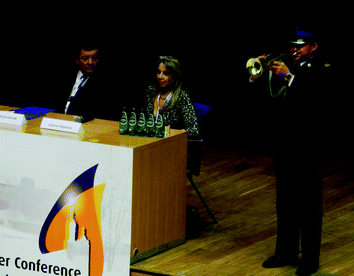2013 European Winter Conference on Plasma Spectrochemistry
Joanna Szpunara and Pawel Koscielniakb
aChair of the 2013 EWCPS, National Scientific Research Council of France, France
bCo-Chair of the 2013 EWCPS, Jagiellonian University, Krakow, Poland
The opening ceremony featured, in addition to welcome addresses, the Plasma Award Ceremony. This Award—sponsored by Agilent Technologies and awarded by the independent scientific panel—was attributed to Norbert Jakubowski (BAM, Berlin, Germany). The laudation was delivered by Klaus Heumann, and then Norbert, who is a European representative Board Member for JAAS, presented his award winning research in a dynamic lecture which was very appreciated by the audience. Another memorable moment was the summary of the background, history and milestones of the Winter Plasma meetings given by Gary Hieftje from Indiana University, US. The final point of the opening was the offering of an enormous cake to Norbert Jakubowski who celebrated his 60th birthday during the meeting.
 | ||
| Fig. 1 Plasma Award winner Norbert Jakubowski, BAM, Berlin, Germany. | ||
The scientific sessions were devoted to fundamentals and instrumentation (Monday, February 11th), stable isotope analysis and HR ICP MS (Tuesday, February 12th), glow discharge (Wednesday, February 13th), elemental speciation (Thursday, February 14th) and laser ablation (Friday, February 15th). Each session was inaugurated by an honorary lecture given by a notable researcher in the field, and a plenary presentation. The five honorary speakers included living legends of plasma source spectroscopy: R. Samuel Houk, Klaus Heumann, Les Ebdon, Freddy Adams, and Jean-Michel Mermet who with the Krakow lecture finished his 45 years long scientific career and who was particularly warmly applauded by the audience. Also, the presentation of Freddy Adams showing the evolution of atomic spectroscopy on the general background of the development of our civilization, was very appreciated by the audience.
The session on fundamentals and instrumentation was inaugurated by Gary Hieftje who discussed the latest instrumental developments in plasma spectroscopy. Alex Haliday presented the potential of high precision isotopic ratio measurements for the studies of planet formation and Detlef Guenther presented the broad spectrum of applications of laser ablation techniques. The lecture by Joerg Feldmann entitled provocatively “Are we measuring the important species or only those we can measure?” opened the speciation session, and Alfredo Sanz-Medel inaugurated the session on glow discharge techniques. The keynote lectures given by already established and young emerging scientists were followed by 99 oral and 222 poster communications reflecting the state-of-the-art techniques in the respective fields of plasma spectroscopy. Four poster prizes sponsored by JAAS (1, RSC) and Analytical and Bioanalytical Chemistry (3, Springer) were attributed to Georgia Sanabria, Tea Zuliani, Orsolya Egressy-Molnar and Anna Konopka, respectively.
An important part of the meeting was the exhibition of instrument and equipment manufacturers and publishers of scientific literature. The special partners included Agilent Technologies, Bruker and Thermo Scientific. Their contributions not only complemented the scientific program by presentation of the latest instrumental developments, application capabilities of the instruments, round table discussions and, last but not least, arranged evening receptions where present and future users of Agilent, Thermo and Perkin-Elmer spectrometers could appreciate the music, good food and excellent company. In total, the exhibition presented featured 32 companies. A number of short courses organized by world leading scientists were also available to the participants.
The participants could also enjoy a wide range of social events including a get-together party, the opening of the exhibition, the hot plasma party and the gala dinner. The guests will surely remember the folk Hot Plasma party in the Zalesie Folwark Inn outside Krakow where they were welcomed by a folk band playing traditional music and serving local liqueurs. After a short performance of Polish folk dancing and music, the participants could taste exquisite traditional local cuisine. Then many joined the dance floor for an unforgettable night of dancing and non-stop refreshments. Everybody had a great time.
The Gala Dinner took place in the captivating interior of the Wieliczka Salt Mine, one of the most valuable monuments of culture visited each year by more than a million tourists from all over the world. The dinner was served in the Warszawa Chamber, formed after a long period of salt mining, located ca. 150 m under the ground.
All the participants were also invited to a walking tour through the streets of Old Krakow. They could admire the Wawel Cathedral and then, following the Kings' Road towards one of the biggest market squares in Europe—the Main Market Square—had the opportunity to have a glimpse of famous monuments such as the medieval cloth hall (Sukiennice), St. Mary's Basilica with the traditional bugle call sounded every hour from the tower, and the medieval university buildings including Collegium Maius.
 | ||
| Fig. 2 Delegates in the Main Market Square, enjoying the walking tour through the streets of Old Krakow. | ||
The closing ceremony was exceptionally well attended and took place in a warm atmosphere. Everybody was persuaded that this week which was spent together in the beautiful winter setting of Krakow brought new ideas, new friendships and the promise of new projects and achievements which will be presented at the next 2015 European Winter Conference on Plasma Spectrochemistry.
 | ||
| Fig. 3 Joanna Szpunar and Pawel Koscielniak, Chair and co-Chair of the 2013 EWCPS during the Opening Ceremony. | ||
| This journal is © The Royal Society of Chemistry 2013 |
